The Middle East is a magnificent saga—a cradle of ancient civilizations and a land of stunning complexity, inhabited by some of the world’s warmest and most welcoming people.
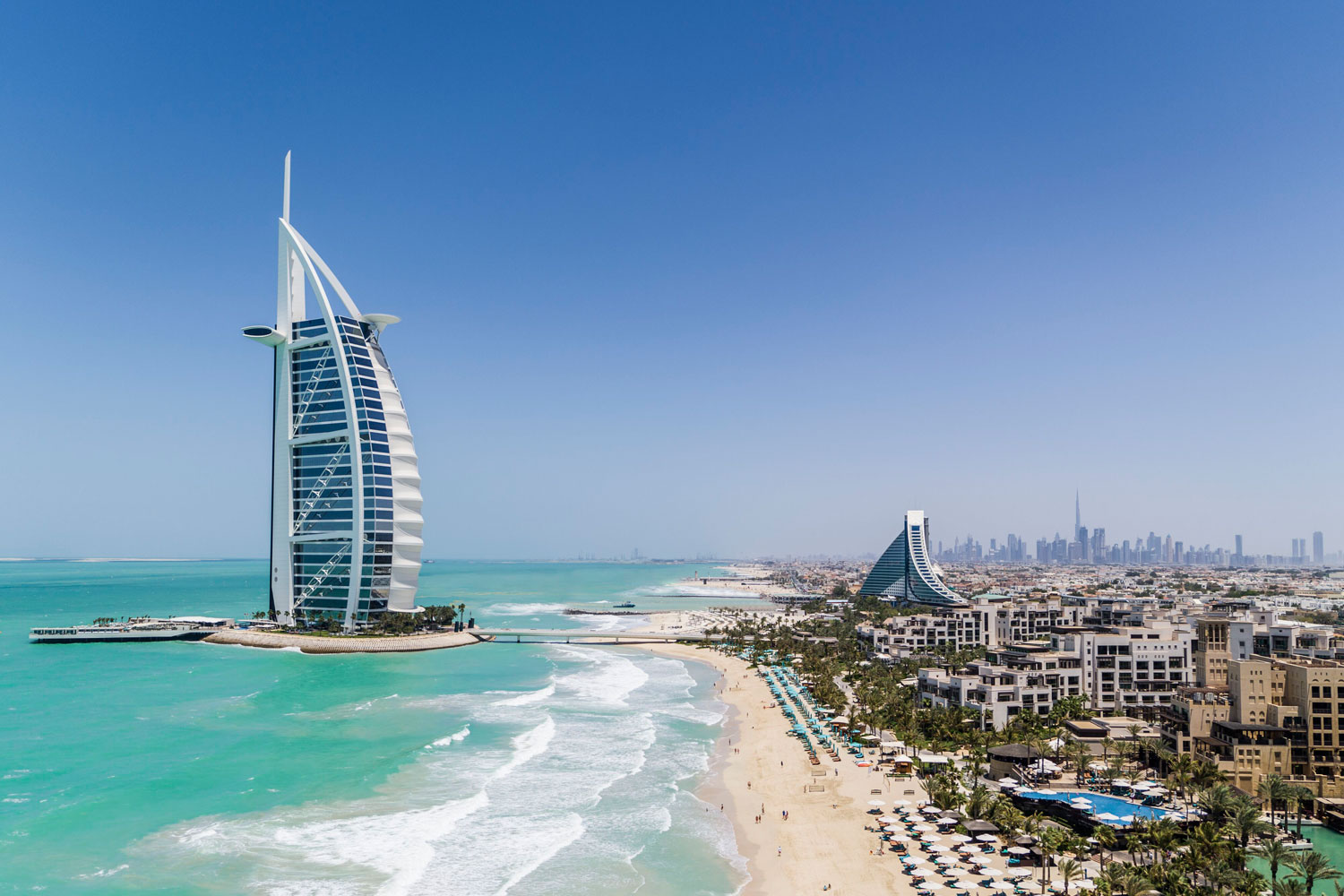
Shaped like the sail of a traditional dhow, the Burj Al Arab is to Dubai what the Eiffel Tower is to Paris—its unmistakable symbol. Completed in 1999, this ultra-luxury hotel rises from its own artificial island and boasts a helipad, gold-drenched interiors, and a fleet of Rolls-Royces.
You’ll need a reservation for afternoon tea, cocktails, or a meal to get past lobby security if you’re not staying here—but it’s worth it just to marvel at the extravagance. Inside, a soaring 590ft atrium dazzles with gold-leaf columns, vivid colors, and a dramatic fountain. The space is so vast it could fit the Statue of Liberty inside.
At 321 meters, the Burj Al Arab was the world’s tallest hotel when it opened. Designed by British architect Tom Wright, its sail-like form and translucent façade shield against the desert sun by day and light up like a beacon by night. Inside, British-Chinese designer Khuan Chew went all-in on luxury: gold, marble (sourced from Michelangelo’s quarry), chandeliers, and ornate details flood every corner.
From the sea, sharp-eyed visitors may spot an accidental architectural twist—the hotel’s top structure forms what some say is the largest cross in the Middle East.
Skyview Bar on the 27th floor offers sweeping Gulf views, with a menu of cocktails and afternoon teas (reservations and minimum spend required). For something more theatrical, Gold on 27 mixes inventive drinks in a gilded setting.
Downstairs, Al Mahara offers a surreal seafood experience, with tables wrapped around a massive aquarium filled with exotic marine life. Arrive via a ‘submarine’ elevator, and dress to impress.
For the perfect sunset shot with the Burj in the background, head to Jumeirah Public Beach—great for a swim, day or night (thanks to floodlights), and free beachfront Wi-Fi via “Smart Palms.”
The Burj’s two-story suites start at 1829 sq ft and come with personal butlers, mirrored ceilings, and 24-karat gold accents. But if you’re not ready to splurge, hotels near the Mall of the Emirates offer more budget-friendly stays with easy access to the area.
Take the Metro to Mall of the Emirates, then hop in a taxi or take buses 8, 81, or 88.
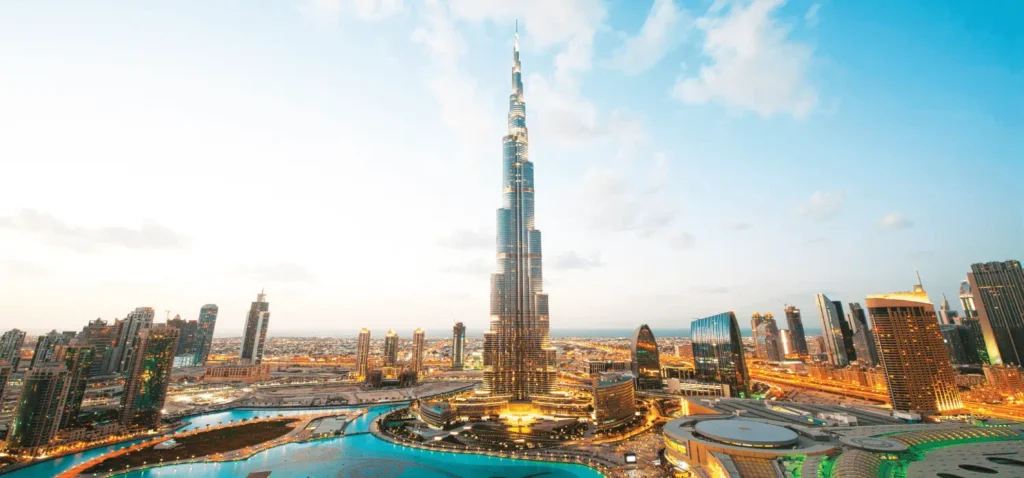
Soaring to a dizzying 828m (2,715ft), the Burj Khalifa isn’t just the tallest building in the world—it’s a marvel of engineering and design. Opened in 2010 after six years of construction and the efforts of 13,000 workers, this sky-piercing tower offers jaw-dropping views, sleek dining experiences, and record-breaking stats at every turn.
Tickets:
Book online up to 30 days in advance—especially if you’re aiming for sunset (peak prices apply). Timed entry is enforced, and slots can sell out fast. Allocate at least 2 hours for your visit.
Pro Tip: On hazy days, views can disappoint. Opt for a nighttime visit instead—no refunds are given for poor weather or terrace closures.
At the Top (124th floor, 1483ft):
Zoom up via a high-speed elevator and step onto the popular viewing deck. Use digital telescopes to peek into the past, simulate night views, or zero in on far-off landmarks.
At the Top Sky (148th floor, 1820ft):
For the ultimate experience, this VIP deck includes refreshments, a guide, and interactive screens that let you “fly” to Dubai’s top sites. You’ll then descend to the 125th floor for the immersive “Falcon’s Eye View.”
At.mosphere (122nd floor, 1450ft) is the world’s highest restaurant, pairing fine dining with sweeping views. Rich interiors and a sleek menu make it a favorite for splurging. The lounge above offers cocktails without committing to dinner. Note: strict dress code, minimum spend, and no kids under 10.
Designed by Skidmore, Owings & Merrill (Chicago), inspired by the desert lily.
11.5ft-thick foundation; 100,000 elephants’ worth of concrete.
28,261 glass panels make up the facade (cleaning takes up to 4 months).
Records held include:
World’s tallest structure
Highest outdoor observation deck (1820ft)
Highest restaurant (122nd floor)
Longest elevator (1653ft)
World’s highest occupied floor (160th)
Fun Fact: In 2011, climber Alain Robert scaled the Burj in just over six hours. In 2014, two Frenchmen base-jumped from the top.
The Armani Hotel occupies 15 floors within the tower itself—ultra-stylish but pricey. For other upscale stays, Downtown Dubai is packed with international luxury chains and some standout boutique options. This is one of the city’s liveliest and most walkable neighborhoods.
Baker & Spice: Organic dishes and salads with Burj and lake views.
Majlis (Dubai Mall): Sip a camelccino (yes, cappuccino with camel milk) in a modern souk setting.
Hop on the Dubai Metro to Burj Khalifa/Dubai Mall. From there, follow signs or grab a taxi for a quick ride to the tower.

One of Dubai’s most atmospheric destinations, Madinat Jumeirah is a luxurious reimagining of a traditional Arab village, blending old-world charm with modern sophistication. Think desert-hued buildings adorned with wind towers, palm-shaded canals, and opulent villas—all with the iconic Burj Al Arab gleaming in the background. By night, it’s pure magic, with softly lit gardens and reflections dancing across the waterways.
Inspired by Dubai’s original creekside settlement in Bur Dubai, Madinat Jumeirah is a modern tribute to traditional Arabian design. Architects integrated historic elements like wind towers, wooden abras, and meandering canals to evoke an old village atmosphere—albeit one with five-star polish. The resort is made up of three lavish hotels and dozens of private villas set in lush, manicured gardens.
At the heart of the complex lies the Souk, a labyrinth of wood-framed walkways with around 75 boutique shops selling everything from fine art and crafts to high-quality souvenirs. While the setting may feel a bit staged, the selection is impressive. The Madinat Theatre also offers a dose of culture, and the many cafés and restaurants—especially those overlooking the canals—make for a lovely shopping break.
Take a 20-minute abra ride through Madinat’s 2.5 miles (4km) of canals and glide past bougainvillea-laced gardens and swaying palms with stunning views of the Burj Al Arab. These traditional-style wooden boats depart regularly from the Souk waterfront near Trader Vic’s. No booking required. If you’re dining or staying at the resort, you may even ride for free.
In Dubai, Friday brunch is more than a meal—it’s an event. Al Qasr and Mina A’Salam, two of the resort’s luxury hotels, are famous for their extravagant spreads featuring roast meats, fresh seafood, sushi, mezze, and entire rooms devoted to cheese and dessert. Reserve early—these brunches are a Dubai institution.
Madinat is also home to the Dubai Turtle Rehabilitation Project, which has helped return over 560 rescued turtles to the wild. Visitors can view the turtles in a sea-fed lagoon at Jumeirah Al Naseem, free of charge. Feeding takes place Wednesdays at 11am. Look for the critically endangered hawksbill turtle, whose nesting females number fewer than 8000 worldwide.
For a tranquil end to your day, join a sunset yoga session on Madinat’s private beach, with the Burj Al Arab rising just beyond your mat. Classes are held daily through the Talise Spa (Dhs90/$24.50). Time your visit with the lunar cycle for Full Moon Yoga—an unforgettable experience beneath the stars.
Luxury: Madinat Jumeirah’s three five-star hotels or the Burj Al Arab offer opulence with views to match.
Midrange: Head inland to the Mall of the Emirates area, where a cluster of hotel-apartments offers solid value and quick access via taxi or bus.
Pierchic: For romantic seafood dining over the Gulf, book well in advance.
Bahri Bar: Enjoy sunset cocktails on the rug-lined terrace with unbeatable Burj views.
Happy Hour: Many bars around the souk and canals run sunset specials worth timing your visit around.
Take the Dubai Metro to Mall of the Emirates, then hop in a taxi or bus (routes 8, 81, 88) to Madinat Jumeirah. Once inside, the resort is best explored on foot—or by abra.

Nestled just north of Jumeirah Public Beach, Kite Beach is one of Dubai’s most popular coastal destinations, especially for the active crowd. From kitesurfing and beach volleyball to kayaking and beach tennis, there’s plenty to keep adventure-seekers busy. A jogging track and shaded skatepark add to the beach’s sporty vibe.
The beach is impressively clean and well-maintained, with facilities including showers, free Wi-Fi, toilets, and changing rooms. You’ll also find a tempting lineup of food trucks, cafés, and ice cream stands just steps from the sand. Kite Beach also offers spectacular views of the Burj Al Arab, making it a favorite spot for both leisure and photography.
It’s a hotspot on weekends, especially Fridays and Saturdays, when a lively seaside market featuring local crafts and gifts adds to the buzz.
Getting There
Kite Beach is located behind Saga World on Jumeirah Road, with ample parking near Al Manara Mosque. Entry to the beach is free of charge.
Food lovers won’t go hungry here. Just off the beach are casual yet trendy dining spots such as:
Circle Café – perfect for breakfast, brunch, and smoothies
X Factor – known for juicy burgers and steaks
Tomato & Basilico – serving up comforting Italian favorites
Not to mention the ever-popular Salt food truck, famous for its gourmet sliders.
If you’re looking to stay close to the beach:
Beach Walk Hotel
Park Regis Boutique Jumeirah
Both are within a 25–30 minute walk of Kite Beach and offer convenient, comfortable stays.
For a more luxurious experience, consider the iconic Burj Al Arab or the stunning resorts at Madinat Jumeirah. Travelers on a midrange budget will find excellent value in the hotel-apartments near Mall of the Emirates.
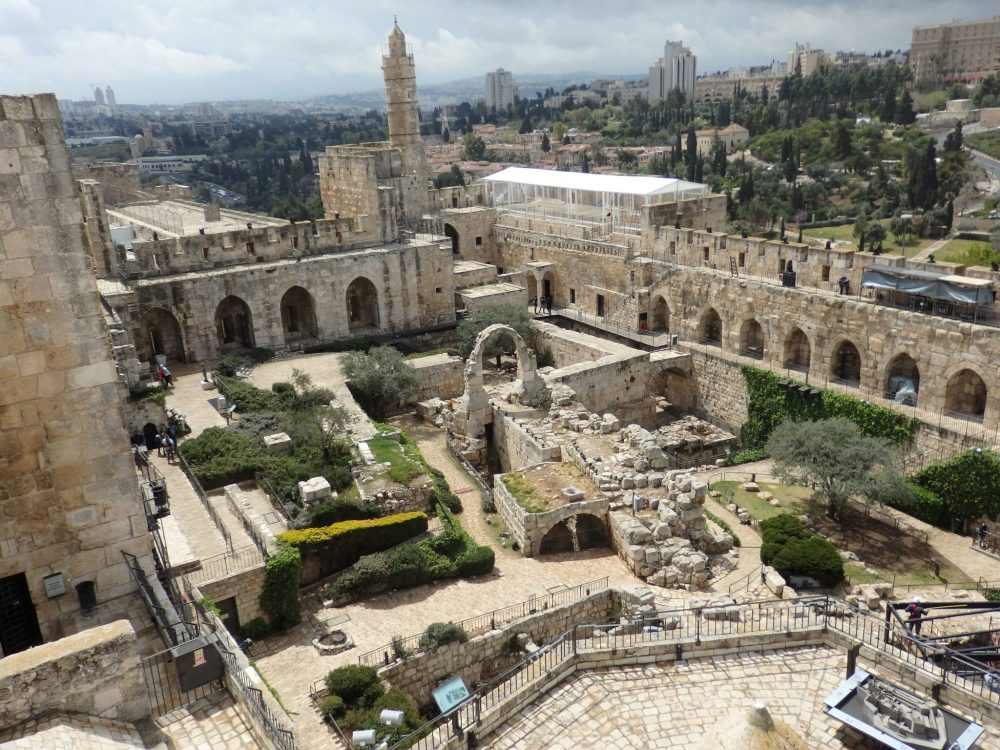
Dominating the entrance to Jerusalem’s Old City via Jaffa Gate, the Tower of David is a striking citadel with a long and layered history. Despite the name, it has no connection to King David. The site originally housed Herod the Great’s palace, built with three massive towers, one modeled after the Lighthouse of Alexandria. After Herod’s death, the Romans used the site, and it may have been where Pontius Pilate judged Jesus (John 18:28–19:16).
Over the centuries, the citadel was expanded and remodeled by Byzantines, Muslims, Crusaders, Mamluks, and Ottomans. Suleiman the Magnificent made significant additions in the 16th century, including the current entrance gate. Misidentified in the 19th century, the Ottoman minaret became wrongly associated with King David, giving the complex its enduring name.
Today, the citadel houses the Museum of the History of Jerusalem, tracing the city’s story from the 2nd millennium BCE to 1948 through engaging, chronologically arranged exhibits. A major redesign is underway to reorganize displays thematically and introduce more authentic artifacts and multimedia installations.
Kishleh Excavations
In 2018, the Kishleh, once a British prison and Ottoman barracks, opened to the public. Excavations revealed Herod’s palace foundations, Crusader-era dyeing vats, and even 8th-century BCE walls linked to King Hezekiah—a rare remnant from the First Temple period. Thirty-minute English tours run on Friday mornings by reservation.
Virtual Reality Walking Tours
The Tower of David Innovation Lab launched VR tours in 2018. Walk from the Citadel to the Western Wall wearing goggles that recreate ancient Jerusalem in immersive 360° detail. Book online in advance. Lab visits are possible by email request.
Panoramic Views & Audio Guide
The Citadel’s ramparts provide sweeping views of modern and ancient Jerusalem—a perfect orientation stop when you arrive. Grab an audio guide (15NIS) in one of seven languages, or download the museum’s mobile app ahead of time.
The Night Spectacular is a 45-minute sound-and-light show that illuminates the Citadel’s walls with vivid imagery narrating Jerusalem’s history (55NIS adults / 45NIS children). The King David Show, launched in 2018, uses impressionistic animation and music to tell the biblical figure’s story. Shows run five nights per week, with start times based on sunset. Advance reservations are strongly recommended.
In summer, the Citadel hosts open-air art exhibitions, often featuring interactive or family-friendly elements. In 2018, life-sized paper sculptures of historical figures adorned the ruins. A garden café with Wi-Fi is open Sunday to Thursday 9am–4pm and Fridays until 2pm.
Nearly 75% of the museum and Night Spectacular are accessible to visitors with disabilities.
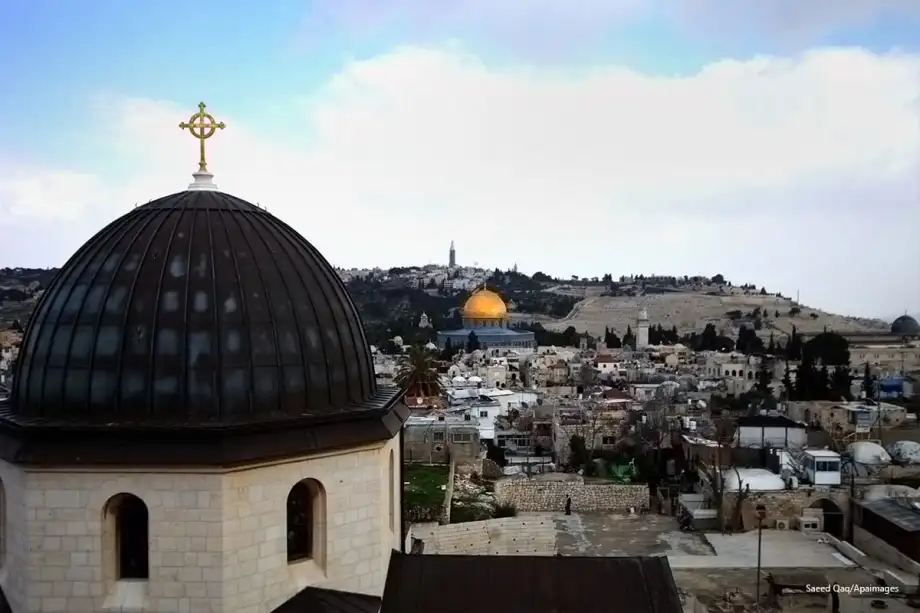
Marked by four majestic arches adorned with Crusader crosses, the Church of the Holy Sepulchre stands as one of Christianity’s most revered sites. Believed by many to be the location of Jesus’s crucifixion, burial, and resurrection, it has drawn pilgrims for more than 1600 years. Crowds are common—quiet contemplation is best sought early in the morning.
Located where the Christian and Muslim Quarters meet, the church is tucked into a courtyard and can appear almost hidden from view—until you’re suddenly standing before it.
The church encompasses the final five Stations of the Cross (10–14), making it a deeply emotional stop for many pilgrims walking the Via Dolorosa:
10th Station: A small chapel marks the spot where Jesus was stripped of his garments.
11th Station: Believed to be where Jesus was nailed to the cross.
12th Station (Calvary): An altar above the Rock of Calvary allows visitors to reach into a hole and touch the stone.
13th Station: Commemorates Jesus being taken down from the cross.
14th Station: The Tomb of the Holy Sepulchre, located beneath the grand rotunda.
The church owes its foundation to Helena, mother of Roman Emperor Constantine the Great, who visited Jerusalem in 326 CE. Believing a pagan temple built by Emperor Hadrian was covering the true site of Christ’s tomb, she had it demolished and excavated—leading to the discovery of three crosses, which she took as a divine sign that this was Calvary.
Constantine’s church was dedicated in 335 CE. While it now stands within the Old City, the site was originally outside the city walls, as Roman law required executions to be carried out beyond them.
In 638 CE, Caliph Omar refused to pray inside the church to preserve it for Christians.
In 1009, it was destroyed by Caliph al-Hakim, and slowly restored over the next decades.
The Crusaders entered the church in 1099 and made major modifications, giving the church much of its current structure.
After the Crusaders’ defeat in 1187, some access points were sealed, though remnants like the carved lintel remain (now in the Rockefeller Museum).
A fire in 1808 and a devastating earthquake in 1927 prompted repairs—but political and religious tensions delayed progress for decades.
In 2016, a long-awaited $4 million restoration of the Tomb of the Holy Sepulchre finally stabilized the shrine, thanks to rare cooperation between the six Christian denominations that share custody of the church: Greek Orthodox, Roman Catholic, Armenian, Coptic, Syrian, and Ethiopian Orthodox.
Keys & Custodians: To avoid conflict over ownership, the Nusseibeh family, a respected Muslim family, has held the church keys since Saladin’s time. They still unlock and lock the doors daily.
Relics & Rituals: While relics like the True Cross are no longer on display, pilgrims still pour oil on the Stone of Unction, believed to be where Jesus’s body was anointed, and take home handkerchiefs soaked in the oil as souvenirs.
Modest Dress Required: Bare shoulders, legs, or backs may result in being denied entry.
Access Routes:
Main Entrance: Christian Quarter Rd
Alternative Entrances: Via Dabbaga Rd (from Souq Khan al-Zeit or Mauristan Rd) or via the Ethiopian Monastery rooftop
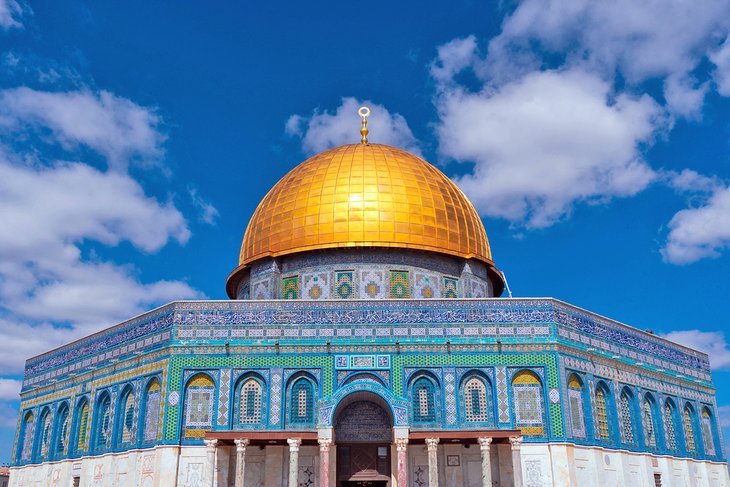
One of the world’s holiest—and most contested—religious sites
Few places on earth evoke as much reverence, emotion, and contention as this elevated plaza in the southeastern corner of Jerusalem’s Old City. Known to Muslims as Al Haram Ash Sharif (The Noble Sanctuary) and to Jews as Har HaBayit (Temple Mount), it is a cornerstone of faith for Islam, Judaism, and—by extension—Christianity.
For Muslims, the site houses two of Islam’s most venerated shrines:
The Dome of the Rock (built ~691 CE)
The Al Aqsa Mosque (~705–715 CE)
For Jews, the area is revered as the site of the First and Second Temples, making it the holiest place in Judaism. For visitors, religious or not, this 140-acre platform is a place of silent awe, though getting in requires patience: expect queues and strict security checks. Modest dress is required.
Once inside, the contrast with the crowded Old City is immediate. The compound is peaceful and expansive, planted with cypress trees and fringed by graceful Mamluk-era buildings. In addition to worshippers, locals come here to relax, walk, or play—it’s the largest open space in East Jerusalem.
The Dome of the Rock, with its golden dome, stands near the center of the plaza. Its foundation rock—al-Sakhrah—is sacred to both Jews and Muslims.
Jewish belief holds that this is where:
God formed Adam from the earth
Abraham nearly sacrificed his son Isaac (Genesis 22)
David built an altar, later expanded by his son Solomon into the First Temple
According to the Talmud:
Solomon’s Temple took 7½ years to build but remained unused for 13 years
The Ark of the Covenant was kept here
Only the High Priest could enter the inner sanctum—once a year on Yom Kippur
The First Temple was destroyed in 587 BCE by Babylonian king Nebuchadnezzar II. A Second Temple, initiated by Zorobabel and vastly expanded by Herod the Great, replaced it. Herod reinforced the mount with massive retaining walls—some stones weigh over 500 tonnes, visible today at the Western Wall.
The Romans destroyed the Second Temple in 70 CE, yet left a temple to Zeus and later a Christian church in its place.
Islamic reverence for the site stems from the Prophet Muhammad’s Night Journey (Isra and Mi’raj), during which he is believed to have traveled to the “farthest mosque” and ascended to heaven from here, leading the prophets in prayer.
Though Jerusalem isn’t named directly in the Quran, early Islamic tradition identified this spot as the “farthest mosque,” making it Islam’s third-holiest site after Mecca and Medina.
Caliph Omar built a simple mosque here in 638 CE
The Dome of the Rock was constructed in 691 CE
The Al Aqsa Mosque followed shortly after (~705–715 CE)
In the 19th century, explorers discovered over 30 cisterns under the plaza—some as large as 50 meters long and 20 meters deep. Religious sensitivities have prevented modern excavation, so what lies beneath remains largely mysterious.
After capturing East Jerusalem in the 1967 Six-Day War, Israeli authorities allowed Muslim religious leaders (Waqf) to retain custodianship of the site—a move meant to preserve peace. However, the decision remains controversial among nationalist Jewish groups, with sporadic tensions and protests ever since.
Many Orthodox Jewish authorities discourage visits altogether, fearing inadvertent entry into the former Holy of Holies, the most sacred part of the ancient Temple.
Non-Muslim prayer is strictly forbidden
Access for non-Muslims is limited to specific hours, generally weekday mornings
Queues form early, especially at the Mughrabi Gate (the only entrance for non-Muslims)
Dress modestly (covered shoulders and legs); entry may be denied otherwise
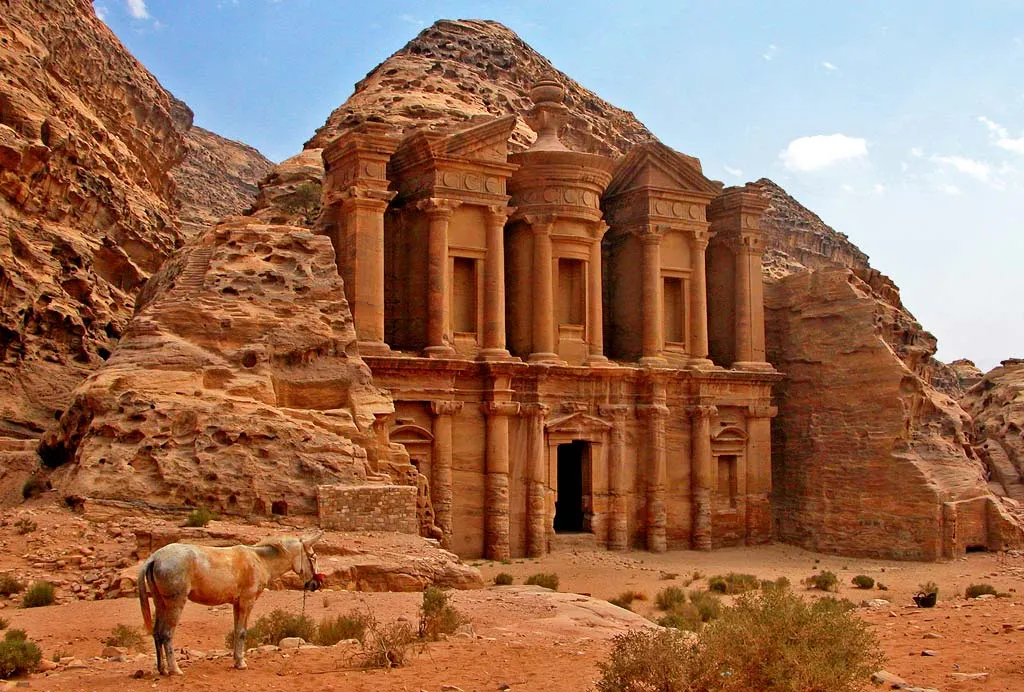
Jordan’s crowning archaeological treasure and a World Heritage marvel
Carved into vivid sandstone cliffs by the Nabataeans in the 3rd century BC, Petra is a monumental ancient city that stuns with its scale, artistry, and natural beauty. Once a thriving trade hub linking Arabia to Damascus, Petra’s strategic location made it a center for commerce, engineering, and spirituality. Today, it remains Jordan’s most iconic site, and no visit to the country is complete without at least two full days to explore its winding trails and rock-hewn wonders.
All visits begin from the adjacent town of Wadi Musa, the transport and accommodation base for Petra. From here, a short walk leads to the entrance of the Siq, the unforgettable gateway to the ancient city.
Petra’s dramatic entrance is the Siq, a narrow, 1.2km-long canyon with towering cliffs torn apart by ancient tectonic forces. As you reach its end, the canyon suddenly opens to reveal the site’s most iconic monument: the Treasury (Al Khazneh).
Carved from iron-rich sandstone, the Treasury was originally a tomb but later inspired myths of hidden treasure—hence its name. Its Greek-style columns, intricate friezes, and dramatic scale are nothing short of awe-inspiring.
From the Treasury, the canyon widens into the Outer Siq, lined with over 40 carved tombs known as the Street of Facades. Continue along until you see steps to the left that lead up to the High Place of Sacrifice—a panoramic altar atop a mountain. It’s a steep but rewarding 45-minute climb.
On your descent, pass through the Garden Tomb, Roman Soldier’s Tomb, and Garden Triclinium, rejoining the main path not far from the Theatre, a 7000-seat structure carved directly into the mountain.
Directly opposite the Theatre, another staircase climbs toward the Royal Tombs, which boast some of the finest carving in Petra. Among them:
The Urn Tomb, with an arched portico
The Palace Tomb, a three-storey facade of grandeur
Continue past these to ascend to a hidden plateau above the tombs. Ask the nearby tea vendor (if present) to point out a rare aerial view of the Treasury. Descend via the same route or look for a rugged staircase leading back to the Urn Tomb.
Returning to the Theatre, head west along the Colonnaded Street, once lined with markets and fountains. Along the way:
View the remains of the nymphaeum
Explore the Great Temple, elevated and expansive
Cross the wadi to reach the Temple of the Winged Lions
At the far end lies Qasr Al Bint, one of Petra’s few free-standing structures. This once-ornate temple is believed to have been dedicated to a Nabataean deity.
Two main restaurants sit just beyond Qasr Al Bint:
The Nabataean Tent Restaurant (left side of the wadi)
The Basin Restaurant (right side, more upscale)
Both offer hot meals and refreshments. Numerous smaller stalls throughout Petra sell tea, water, and light snacks.
Behind the Tent Restaurant is the small hill of Al Habis (“the prison”). A one-hour round walk takes you past Wadi Siyagh, eventually leading to the ruins of a Crusader fort (built AD 1116). The hilltop views across Petra are breathtaking and well worth the effort.
To reach Petra’s second-most famous monument, the Monastery, begin from the Basin Restaurant. A rock-cut staircase winds upward for 45 minutes, ending in a sweeping vista crowned by Al Deir’s enormous sandstone facade—even larger than the Treasury.
Built around 86 BC as a tomb, the Monastery was later used by Byzantine monks, which earned it its modern name. Visit in the late afternoon, when the fading sun ignites the colors of the rock.
Don’t miss:
Two short trails to clifftop viewpoints
A glimpse of Jebel Haroun and Wadi Araba
The Lion Tomb, near the base of the return path
Start early to beat the heat and crowds
Wear good hiking shoes – many trails involve uneven steps and inclines
Bring water, sunscreen, and a hat
Allow 2 full days minimum to explore properly
Don’t skip sunset at either the Monastery or a high viewpoint above the Royal Tombs
WhatsApp us